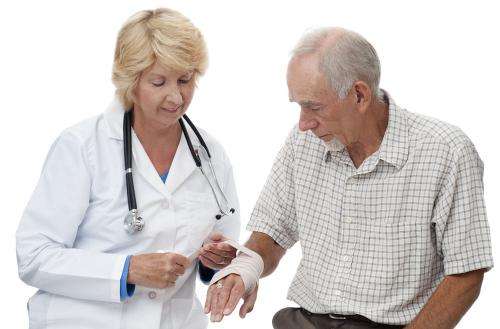Rise in falls and fractures among elderly after Superstorm Sandy

Everyone knows Superstorm Sandy left many New Jersey homes and businesses battered and bruised.
But most are not aware of the considerable toll the storm and its aftermath took on our state's residents.
"With disasters, there are things beyond the obvious," said Rutgers' Sue Shapses, a professor in the department of Nutrition and chair of the Interagency Council of Osteoporosis. "There are real health hazard risks, especially falling and fracturing. And it's especially a problem for our elderly population."
Based on a report Shapses wrote using data from the New Jersey Hospital Association that showed state hospitals experienced an 18 percent increase in visits related to falls and a 13 percent increase in visits related to fractures, during the week following the storm in comparison to the week prior. Of those who sought medical attention for falls and fractures after the hurricane, there was a 40 percent rise in falls and fractures in those who were 65 or older.
One of them was Shapses' mother, who fell and fractured her wrist during a late-night trip to the bathroom in Shapses' darkened Milltown home.
"When it's dark, it's easy to trip on things, even if you're in your own house. Many older people were moving to new and sometimes cramped locations. Learning a new way to navigate to that bathroom in the middle of the night is very difficult," Shapses said. "We thought we had a lot of flashlights. But in the end, the battery went out in the middle of the night that lit the bathroom."
In the report, "Dramatic Rise in Falls and Fractures After Hurricane Sandy: Another Reason to Be Prepared," Shapses and colleagues Shannon Davilla and Julia P. Grimes attribute the dramatic increase in falls and fractures to extended power outages, such as those that accompanied Sandy, which make navigating especially tricky for seniors.
At least one in three adults 65 and older will fall in the next 12 months, according to the CDC. On average, nearly 200 older adults in New Jersey are admitted to a hospital or emergency room from a fall every day. Fifty percent of falls result in injury and if fracture occurs, quality of life is compromised and the risk of death is increased.
For added safety precautions for seniors and all households, it is recommended to always stock emergency supplies, such as batteries, flashlights, first aid kits, medications, non-perishable food and water. Also, it can be helpful to provide whistles to elderly loved ones, so that if injured, the person can send out an easily-recognized distress call of three short blasts.
















